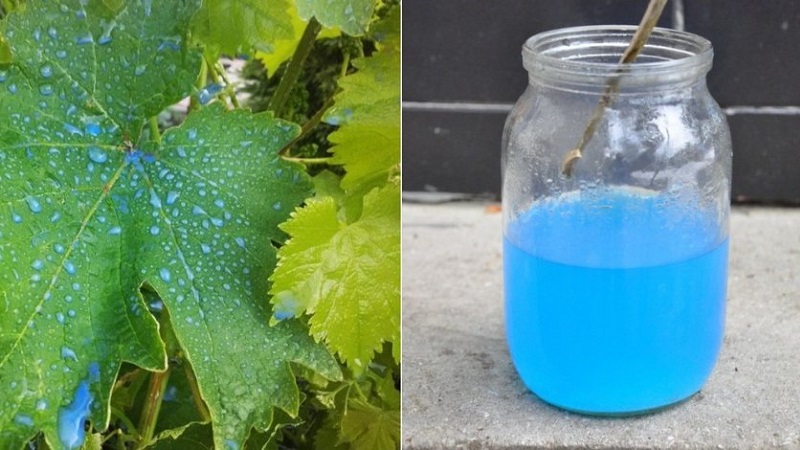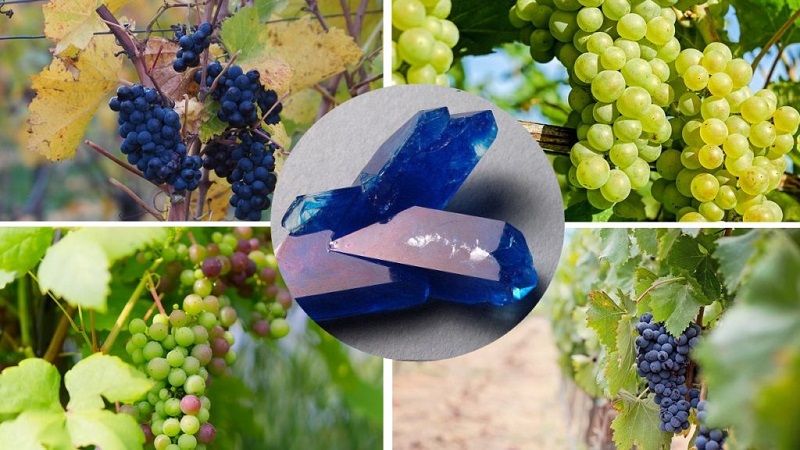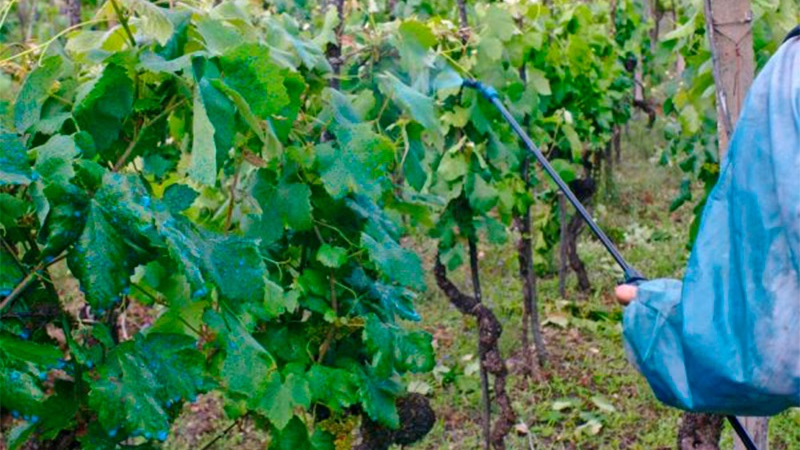How to properly process grapes with copper sulfate in the spring and why is it needed
The processing of grapes with copper sulfate in the spring is carried out in order to protect the plant from fungal infections and insects, maintain protective forces and feed. This is a traditional product that is easy to prepare - just follow the proportions and safety precautions. The granular powder dissolves quickly in water and combines with slaked lime and urea. How and for what copper sulfate is used in gardening - we will tell in the article.
The content of the article
Why process grapes in spring with copper sulfate
Copper sulfate is copper sulfate (sulfuric acid salt), a contact agent that is used to fight against rot, scab, spotting, saturation of plants with copper.

The substance is used for feeding grapes grown on poor soils (sandstones, peat bogs). Copper supports photosynthesis and increases the defenses of the grapes. Vine damage by fungi occurs precisely because of nutritional deficiencies. The lack of nutrients is indicated by the slow development of young shoots and the white tips of the foliage.
Reference. Grape seedlings are soaked in a 1-3% solution of copper sulfate before boarding for the prevention of fungal infections.
Processing advantages and disadvantages
The use of copper sulfate has positive aspects:
- the substance is available at any gardening store;
- low cost;
- a wide range of actions;
- effective destruction of fungi;
- treatment and prevention of many diseases of grapes.
disadvantages:
- high toxicity;
- the substance accumulates in the soil, green mass and fruits;
- causes burns to leaves and roots if used uncontrolled.
Comparison with iron sulfate
Copper and iron vitriol differ in composition and properties... Comparative characteristics are presented in the table.
| Parameters | Copper sulfate | inkstone |
| Formula and composition |
CuSO4 (copper, sulfur, oxygen) Copper sulfate |
FeSO4 (iron, sulfur, oxygen) Ferrous sulfate |
| Appearance | Blue, opaque powder | Bluish green, transparent granules |
| Reaction | Sour | Neutral |
| What is it used for | Plant nutrition with copper ions. Protection against fungal infections (mildew, oidium), all types of rot. | Protection against fungal infections, soil disinfection, plant nutrition with iron ions, fight against moss and lichen. |
| Application | As part of an aqueous solution with slaked lime (Bordeaux mixture) or an aqueous one-component solution | Aqueous solution of the substance |
Iron sulfate is less toxic to the environment and cheaper than copper sulfate... A solution of ferrous sulfate is used as a fungicide, although copper is considered more effective. After spraying in the spring, the buds wake up for several days. This treatment is performed to minimize the detrimental effects of recurrent frosts in early spring.

Processing time
Spring processing of vines is performed immediately after the snow melts... This must be done to destroy fungal and putrefactive infections, as well as insect pests.
Specific dates depend on the climatic conditions in the regions... Often the first spraying is carried out at the end of March. During this period, insects become more active, but their concentration in the soil and on the vine is too low, so they cannot cause serious harm yet.Processing is carried out at an air temperature of + 3 ... + 5 ° C in dry, calm weather in the morning or evening. Before spraying, the covering material (needles, dry foliage, spruce branches, brushwood) is removed from the vine and burned. Shelter from boards, slate, plywood are treated with the same solution of copper sulfate.
Processing on green foliage before and after flowering is carried out carefully, strictly observing the dosage... Before the procedure, the bushes are thinned out - excess young shoots are removed.
Reference. The processing of grapes in the south is carried out more often than in the north. This is due to weather conditions favorable for the development of fungal and putrefactive infections. In the northern regions, one spring treatment is often enough; in the southern regions, the vine is sprayed 3-4 times.
How to properly prepare a solution
Copper sulfate is an easily soluble powder, melts best in warm water... Even a beginner can handle the preparation of the solution. For spraying the vineyard, it is recommended to cook a large amount at once.
To prepare a solution of pure copper sulfate, metal containers cannot be used., especially galvanized and iron. This will damage the container and the solution itself. The walls of the dish will be covered with a coating of metallic copper. Therefore, gardeners use plastic buckets and glass jars.

The procedure for preparing a 1% solution:
- Measure out 10 liters of distilled water and heat slightly.
- Pour 100 g of granules into the water in a slow stream.
- Stir the liquid until the granules are completely dissolved.
- If sediment remains at the bottom, strain the solution through cheesecloth.
- Pour the prepared liquid into a container with a spray bottle.
The finished solution of copper sulfate has a light blue tint... The consumption of the working fluid per bush is 1.5-2 liters.
Interesting on the site:
Description of the most delicious grape varieties
How to process grapes with the resulting solution
The procedure for spraying the vineyard is standard and does not depend on the processing period:
- The first step is to spray the top of the bush.
- Then they move to the middle tier.
- Next, the sleeves and the barrel are processed.
- At the end, the support is processed.
- The sprayer mouthpiece is held at a distance of 10-20 cm from the bush, the stream is directed from top to bottom.
Precautions
When working with copper sulfate, it is recommended to observe safety measures:
- Wear protective gloves, goggles, clothing and a respirator.
- Do not mix granules with substances other than lime, urea and soap.
- Carry out work early in the morning or in the evening after sunset, so that the drops last longer on the branches.
- Perform the procedure in dry, calm weather.
- Together with the bushes, irrigate the support to which the vine is tied, since pathogens of fungal diseases also multiply on it.
- It is recommended to shake the mixture during work. Small particles settle to the bottom, and first water gets on the bush, and then a concentrated solution, which causes burns to plant tissue.
- Distribute the solution evenly and avoid over-watering the soil under the bush. To protect the soil, it is recommended to lay dense polyethylene.
- Experienced gardeners advise using fine-dispersed pump or electric sprayers.
- Pour the rest of the solution into a deep hole outside the vineyard - in a place where planting of horticultural crops is not planned.

The use of copper sulfate with other drugs
Copper sulfate can be combined with urea for spring processing of grapes... Urea, or urea, is a concentrated nitrogen fertilizer (46% nitrogen) that is completely safe for plants. The granules of the substance dissolve quickly in water, do not cake during long-term storage. In the summer, a 0.5-1% solution is used for foliar feeding of bushes. In the spring, use a more saturated, 5-7% solution.
Cooking procedure:
- For 8 liters of water, take 700 g of urea and mix until the granules are dissolved.
- 100 g of copper sulfate are dissolved in 0.5 l of water.
- A solution of vitriol is poured into a urea solution in a thin stream and the volume is brought to 10 liters.
Another popular liquid among gardeners is Bordeaux mixture.... The working solution is prepared at one time and is not stored. There is a ready-made mixture on sale with a litmus strip for determining acidity. However, you can prepare the liquid yourself.
To prepare a 1% solution, you need to take three plastic containers... In the first, dissolve 100 g of copper sulfate, in the second - 200 g of slaked lime, and in the third, mix both solutions. A nail is suitable for determining acidity. It is dipped into the prepared solution for 5-7 minutes. If copper deposits appear on the surface, then you need to add a little lime. The absence of plaque indicates a properly prepared solution.
To prepare a 3% solution, use the same plastic container:
- In one container, dissolve 300 g of copper sulfate in 5 liters of water.
- In another container, mix 400 g of lime and 5 liters of water.
- In the third container, both solutions are mixed, which should acquire an unclear blue tint.
Copper sulfate is not recommended to be combined with insecticides and alkaline agents... If necessary, an interval of two weeks is maintained between treatments.
Conclusion
Copper sulfate does not lose its popularity among gardeners, despite the emergence of new means to fight insects and fungal diseases. The finished solution has antiseptic properties, saturates plants with copper, and supports their immunity. In early spring, a concentrated solution of pure copper sulfate is used, constantly shaking the mixture during spraying. The granules can be mixed with urea and hydrated lime.